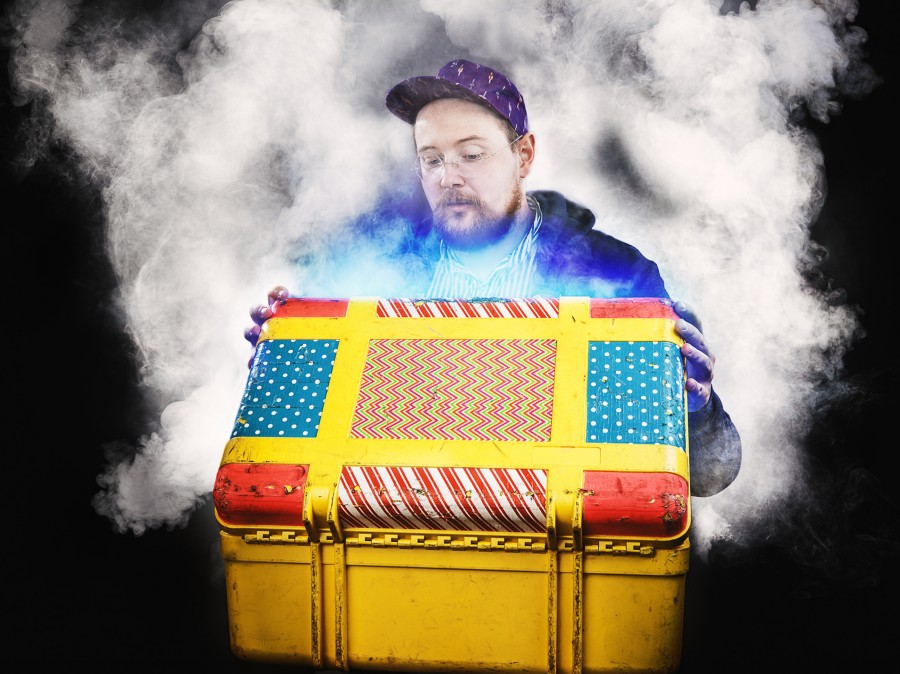The glissando (gliss for short) is a musical term describing the sound of an instrument as it glides from one pitch to another. A favorite trick of jazz hornmen and slide guitarists, the gliss can be a woozy, gleeful sound or a mournful one. When executed by a virtuoso violinist, the notes between the start and the finish of the gliss blur together into a gorgeous, ribbonlike swoop of sound.
A similar effect is available on analog synthesizers, and as a result, it’s become common currency in electronic dance music. Those burbling basslines that glide between octaves are a high-tech variation of the gliss; the sleepy, blissed-out single tones that dwell in the ether of many mixes are another. But those are the conventional expressions, the kind that fit nicely on a software map. Dan Deacon, the Baltimore electronic musician and composer known for his bric-a-brac collages and manic live performances, uses the gliss and similar devices in a different way — to escape the normalcy of pattern-based music. In his schemes, the gliss is a portal to weirdness. He exploits its transitory nature, and uses it to inject slippery bursts of rebellion between the beats. Deacon’s 2007 breakthrough Spiderman Of The Rings (and, really, everything he’s done since) is almost defiantly destabilized, a symphony of wiggling glissandi that sounds, from a distance, like a Rube Goldberg contraption of synchronized moving parts running on bacon fat and ecstasy.
Deacon’s aesthetic has evolved since Spiderman Of The Rings, but a few constants remain — among them the use of expressive devices (like the gliss) to coax a hint of humanity from the dusty circuit boards that dominate his rig. With his new album Gliss Riffer, Deacon emphasizes another, even more radical expression: singing. As in, lyrics. Verse followed by hook. He’s used his voice before, but never in such an overt way. The first voice we hear in “Feel The Lightning” is him sped-up, a dance-floor concoction that sounds odd in this particular maelstrom. Then comes a stark contrast, an almost militaristic male voice; as the song evolves, those and other vocal “characters” take turns in the spotlight.
Deacon pushes the vocals and vocoder tricks of the next track, “Sheathed Wings,” even further, a move that helps make several of his inspirations clear: Though the melodic line is fully his own, his delivery carries echoes of Brian Eno circa Another Green World, crossed with a touch of John Lennon. That’s followed by a tumbling sea-chanty tune that’s as loaded with verbiage as something Phish might have recorded in the 1990s. The aptly titled “Mind On Fire” is possibly the record’s most delirious vocal moment: Against a brisk double-time groove that’s an electronic version of a gospel jubilee, Deacon sets up overlapping waves of voices that are every bit as thick as his instrumental tapestries. Audible within this morass are traces of a somber choir and a solo voice raging punk-like and pitch-free. The resulting collage is juxtapositional and wonderful — a pursuit of the ecstatic that obliterates genre distinctions.
The vocal bent of Gliss Riffer does inherently shift Deacon’s focus; certainly some longtime fans, those who relished the freaky frenzy of his performances, will debate this direction. Listening to the new record, which was recorded partly on the road during last year’s tour with Arcade Fire, you wonder if Deacon felt he’d exhausted the electro-acoustic texture possibilities he explored on Bromst (2009) and America (2012), and was seeking a different structural framework. (This record was recorded entirely solo, the first time he’s done that since Spiderman Of The Rings.) And naturally there are more aesthetic questions, among them: What happens when a master of chaotic sonic overload transitions from music governed by intentional erraticisms to music built around familiar pop-song structures? For the most part, Deacon has managed something remarkable here: He’s not simply holding on to the irreverent spirit of his earlier work, but also using it to keep some distance from pop routine. You get the sense that he’s treating these versions of the songs as kernels — raw materials to be stretched out and mangled in performance.
Deacon doesn’t turn his back on his oldheads, though. The record closes with two more open-ended explorations, essays in riveting abstraction that exhibit a deep understanding of Steve Reich‘s minimalism and an equally deep-rooted desire to experiment. “Take It To The Max” opens with a repetitive nail-gun sound that evolves, like “Wooody Wooodpecker” on Spiderman, into a fitful hiccuping groove. Deacon adds elements like a zen master of orchestral tension — a low piano figure here, a recurring plinking mallet riff over there — and after some journeying, he arrives at a stupendous, rushing-rapids episode that’s positively breathtaking. The album closes with an equally absorbing foray, “Steely Blues,” that’s notable for its wistful mood swings between dark and light.
That emotional dimension, and Deacon’s deft handling of hues and undercurrents and subtext, is part of the allure here. Even when his tunes demand a particular event — say, the flag-waving transition from verse to chorus — Deacon steers well away from the predictable. He’s using tricks from the EDM playbook, but he’s a gloss flipper, carefully avoiding the showy, gaudy stuff. He might use some tools of the DJ trade, but his trances start from a different place, and lead listeners to a more rarefied location. Tunnel through the information overload, and you might just find yourself in awe at the glissed-out ski-slope grace of a single note.
9(MDAxNzk1MDc4MDEyMTU0NTY4ODBlNmE3Yw001))
Playlist
Dan Deacon, 'Gliss Riffer'



